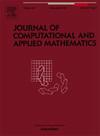Fuzzy random multi-objective optimization using a novel mixed fuzzy random inverse DEA model in input-output production
IF 2.1
2区 数学
Q1 MATHEMATICS, APPLIED
Journal of Computational and Applied Mathematics
Pub Date : 2025-04-15
DOI:10.1016/j.cam.2025.116717
引用次数: 0
Abstract
Inverse data envelopment analysis (DEA), which is an effective tool for determining inputs and outputs, is commonly applied in areas such as output prediction, resource allocation, and target setting. However, existing inverse DEA methods typically assume precise and deterministic data, which limits applicability in uncertain production environments, particularly when both random and fuzzy environments are present. This study introduces a novel inverse DEA approach for optimizing inputs and outputs in mixed uncertainty environments. The proposed model allows decision-makers to achieve target efficiency and meet various input/output targets under different production scale assumptions. First, a new optimality principle for multi-objective fuzzy random problems is presented and the necessary theoretical conditions for input/output calculations are derived. Second, an equivalent linear model is introduced to solve the inverse DEA problem with fuzzy random variables, thereby overcoming the challenges associated with nonlinear programming. Notably, the proposed model offers enhanced flexibility as it does not rely on specific fuzzy numbers or predefined assumptions regarding random distributions. Finally, the effectiveness of the model is validated through numerical examples and a case study, demonstrating its practical application in complex decision-making scenarios.
基于混合模糊随机逆DEA模型的投入产出生产模糊随机多目标优化
反向数据包络分析(DEA)是一种确定投入和产出的有效工具,通常应用于产出预测、资源分配和目标设定等领域。然而,现有的逆DEA方法通常假设精确和确定性的数据,这限制了在不确定生产环境中的适用性,特别是在随机和模糊环境并存的情况下。本文提出了一种新的逆DEA方法来优化混合不确定性环境下的输入和输出。该模型允许决策者在不同的生产规模假设下实现目标效率和满足不同的投入/产出目标。首先,提出了一种新的多目标模糊随机问题的最优性原理,并推导了输入/输出计算的必要理论条件。其次,引入等效线性模型求解具有模糊随机变量的DEA逆问题,克服了非线性规划的困难。值得注意的是,所提出的模型提供了增强的灵活性,因为它不依赖于特定的模糊数或关于随机分布的预定义假设。最后,通过数值算例和案例分析验证了模型的有效性,展示了该模型在复杂决策场景下的实际应用。
本文章由计算机程序翻译,如有差异,请以英文原文为准。
求助全文
约1分钟内获得全文
求助全文
来源期刊
CiteScore
5.40
自引率
4.20%
发文量
437
审稿时长
3.0 months
期刊介绍:
The Journal of Computational and Applied Mathematics publishes original papers of high scientific value in all areas of computational and applied mathematics. The main interest of the Journal is in papers that describe and analyze new computational techniques for solving scientific or engineering problems. Also the improved analysis, including the effectiveness and applicability, of existing methods and algorithms is of importance. The computational efficiency (e.g. the convergence, stability, accuracy, ...) should be proved and illustrated by nontrivial numerical examples. Papers describing only variants of existing methods, without adding significant new computational properties are not of interest.
The audience consists of: applied mathematicians, numerical analysts, computational scientists and engineers.

 求助内容:
求助内容: 应助结果提醒方式:
应助结果提醒方式:


